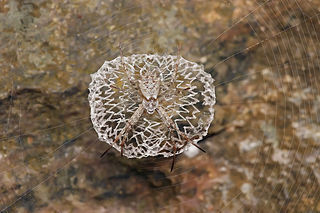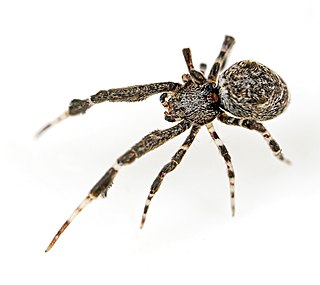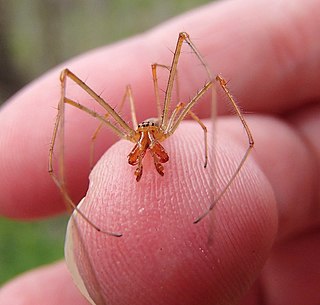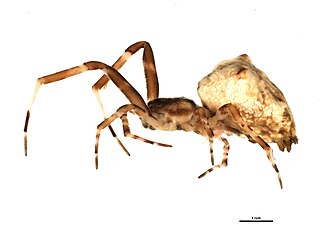
Uloboridae is a family of non-venomous spiders, known as cribellate orb weavers or hackled orb weavers. Their lack of venom glands is a secondarily evolved trait. Instead, they wrap their prey thoroughly in silk, cover it in regurgitated digestive enzymes, and then ingest the liquified body.

Orb-weaver spiders are members of the spider family Araneidae. They are the most common group of builders of spiral wheel-shaped webs often found in gardens, fields, and forests. The English word orb can mean "circular", hence the English name of the group. Araneids have eight similar eyes, hairy or spiny legs, and no stridulating organs.

A stabilimentum, also known as a web decoration, is a conspicuous silk structure included in the webs of some species of orb-web spider. Its function is a subject of debate.

Araneus is a genus of common orb-weaving spiders. It includes about 650 species, among which are the European garden spider and the barn spider. The genus was erected by Carl Alexander Clerck in 1757.

Philoponella is a genus of uloborid spiders. Like all Uloboridae, these species have no venom.

Homalonychus is a genus of araneomorph spiders, and is the only genus in the family Homalonychidae. It was first described by George Marx in 1891. As of May 2019 it contains only three species: H. raghavai, H. selenopoides, and H. theologus. Two are found in the southern United States and Mexico: H. theologus is mostly found west of the Colorado River, while H. selenopoides is mostly found to the east, with some populations in Death Valley and near Mercury, Nevada.

Uloborus walckenaerius, also known as the feather-legged spider, is a cribellate spider in the family Uloboridae. Like all spiders in this family, they do not have venom glands and immobilize their prey with over 140 metres of thread. They are named in honor of Charles Athanase Walckenaer.

Uloborus is a spider genus in the family Uloboridae with 72 described species. Most species occur in the tropics and subtropics, with only few species in northern America and Europe.

Uloborus plumipes is a species of Old World cribellate spider in the family Uloboridae. Common names include the feather-legged lace weaver and the garden centre spider, the latter name being due to its frequent occurrence of this spider in garden centres. The species name is derived from the Latin pluma "feather" and pes "foot".
A social spider is a spider species whose individuals form relatively long-lasting aggregations. Whereas most spiders are solitary and even aggressive toward other members of their own species, some hundreds of species in several families show a tendency to live in groups, often referred to as colonies.

Spiders are air-breathing arthropods that have eight legs, chelicerae with fangs generally able to inject venom, and spinnerets that extrude silk. They are the largest order of arachnids and rank seventh in total species diversity among all orders of organisms. Spiders are found worldwide on every continent except for Antarctica, and have become established in nearly every land habitat. As of August 2021, 49,623 spider species in 129 families have been recorded by taxonomists. However, there has been dissension within the scientific community as to how all these families should be classified, as evidenced by the over 20 different classifications that have been proposed since 1900.
Uloborus georgicus is a spider species found in Georgia.

Philoponella congregabilis, sometimes referred to as the little humped spider, is an Australian species of communal spider that, like other species of Uloboridae, does not use venom. Instead it wraps its prey in spider silk to crush it to death. The spider then goes on to regurgitate digestive fluid into the shroud, then consuming the pre-digested liquid. The specific name congregabilis translates to "community dwellers". The generic name Philoponella alludes to their industrious nature, "loving labour".

Cyrtophora moluccensis is a tent-web spider in the orb-weaver family. It is commonly known as the tent spider or dome-web spider, and is native to India, Japan, Indonesia, Papua New Guinea, Australia, Fiji, and Tonga. It is often found in disturbed or open habitats from coasts to forest and mountainous interiors.

Waitkera is a genus of spiders in the family Uloboridae. It was first described in 1979 by Opell. As of 2021, it contains only one species, Waitkera waitakerensis, found in New Zealand.
Uloborus rufus is a species of spiders of the family Uloboridae. It is endemic in Cape Verde. The species was named and described by Günter E. W. Schmidt and Rolf Harald Krause in 1995.
Philoponella oweni is a species of spider belonging to the family Uloboridae, the cribellate orb weavers. They are around 4.7–7.1 mm long in length and are primarily found in the arid southwestern parts of the United States. These spiders are most known for being semi-social, a rare trait within spiders. Semi-social, in the case of P. oweni, refers to the coexistence of facultatively communal and solitary females within the same habitat. These groups usually form in response to environmental factors, and often never involve true cooperation. This lack of true cooperation means these spiders do not share prey items, do not work together when spinning webs and do not care for one another's young. The coexistence of both solitary and communal species within the same habitat can be explained by both tactics have similar net reproductive success values. This was can be explained by comparing the number of eggs within egg cases to the number of surviving offspring for both tactics. The number of surviving offspring of communal and solitary beings does not vary significantly, which mostly due to the parasitism by pteromalid wasps. These wasp which prefer consume and parasitize communal P. oweni webs and eggs, counteracting the increase of eggs per egg case that communal spiders tend to produce over solitary.

Tetragnatha versicolor is a species of long-jawed orb weaver in the spider family Tetragnathidae. It is found throughout North America, Canada, Central America, and Cuba, but are most common in the United States. T. versicolor is heavily concentrated in New England and the west coast in states like California and Washington. T. versicolor is considered a habitat generalist, and can thrive in many different environments. While they can be found in places like Grasslands, Wetlands, Forests, etc., they prefer dryer areas like normal trees and shrubs. Unlike other spiders in the genus Tetragnatha, T. versicolor will rarely reside near aquatic environments. T. versicolor will typically be colored dark yellow or pale orange and average around 5 mm for males and 6.5 mm for females in length, which is very small for a spider. They are much longer than they are wide, making them very distinct. In addition, T. versicolor can be distinguished from other spiders in Tetragnatha by the distinct separation of the anterior/posterior eyes and the appearance of their reproductive organs. As an orb weaver spider, T. versicolor creates a web to hunt for prey. It will wait at night for prey to stumble into its web and use vibrational signals throughout the web to sense trapped prey. In terms of mating behavior, T. versicolor lacks a distinct courting ritual and will mate with any others in the proximity. Mating behavior is heavily affected by female mating history. In terms of interactions with humans, the bite of T. versicolor is venomous, but not known to cause significant harm.

Uloborus diversus is a species of cribellate orb weaver in the spider family Uloboridae. It is found in the United States and Mexico.
Uloborus canus is a species of spider in the family Uloboridae, found in Australia. The species was first described by W.S. Macleay in 1827. His very brief description said it had a convex white thorax, the first and second legs were equal in length, and the femora were black-spotted. The type specimen has been lost.
















